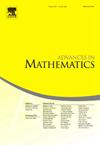Shuffle algebras, lattice paths and Macdonald functions
IF 1.5
1区 数学
Q1 MATHEMATICS
引用次数: 0
Abstract
We consider partition functions on the square lattice with the local Boltzmann weights given by the R-matrix of the quantum algebra. We identify boundary states such that the square lattice can be viewed on a conic surface. The partition function on this lattice computes the weighted sum over all possible closed coloured lattice paths with different colours: n “bosonic” colours and m “fermionic” colours. Each bosonic (fermionic) path of colour i contributes a factor of () to the weight of the configuration. We show the following:
- i)is a symmetric function in the spectral parameters and generates basis elements of the commutative trigonometric Feigin–Odesskii shuffle algebra. The generating function of admits a shuffle-exponential formula analogous to the Macdonald Cauchy kernel.
- ii)is a symmetric function in two alphabets and . When are set to be equal to the box content of a skew Young diagram with N boxes the partition function reproduces the skew Macdonald function .
洗牌代数、格子路径和麦克唐纳函数
我们考虑的是 N×N 方阵上的分割函数,其局部玻尔兹曼权重由 Ut(slˆn+1|m) 量子代数的 R 矩阵给出。我们确定了边界态,从而可以在圆锥面上观察方阵。该晶格上的分治函数 ZN 计算了所有可能的封闭彩色晶格路径的加权和,这些路径有 n+m 种不同颜色:n 种 "玻色 "和 m 种 "费米子 "色。每种颜色 i 的玻色(费米子)路径都会对配置的权重产生 zi (wi) 的影响。我们证明如下:i)ZN 是光谱参数 x1...xN 的对称函数,并生成交换三角费金-奥德斯基洗牌代数的基元。ZN 的生成函数有一个类似于 Macdonald Cauchy 核的洗牌-指数公式.ii)ZN 是两个字母表 (z1...zn) 和 (w1...wm) 中的对称函数。当 x1...xN 设为等于具有 N 个方框的倾斜杨图 μ/ν 的方框内容时,分割函数 ZN 重现了倾斜麦克唐纳函数 Pμ/ν[w-z]。
本文章由计算机程序翻译,如有差异,请以英文原文为准。
求助全文
约1分钟内获得全文
求助全文
来源期刊

Advances in Mathematics
数学-数学
CiteScore
2.80
自引率
5.90%
发文量
497
审稿时长
7.5 months
期刊介绍:
Emphasizing contributions that represent significant advances in all areas of pure mathematics, Advances in Mathematics provides research mathematicians with an effective medium for communicating important recent developments in their areas of specialization to colleagues and to scientists in related disciplines.
 求助内容:
求助内容: 应助结果提醒方式:
应助结果提醒方式:


